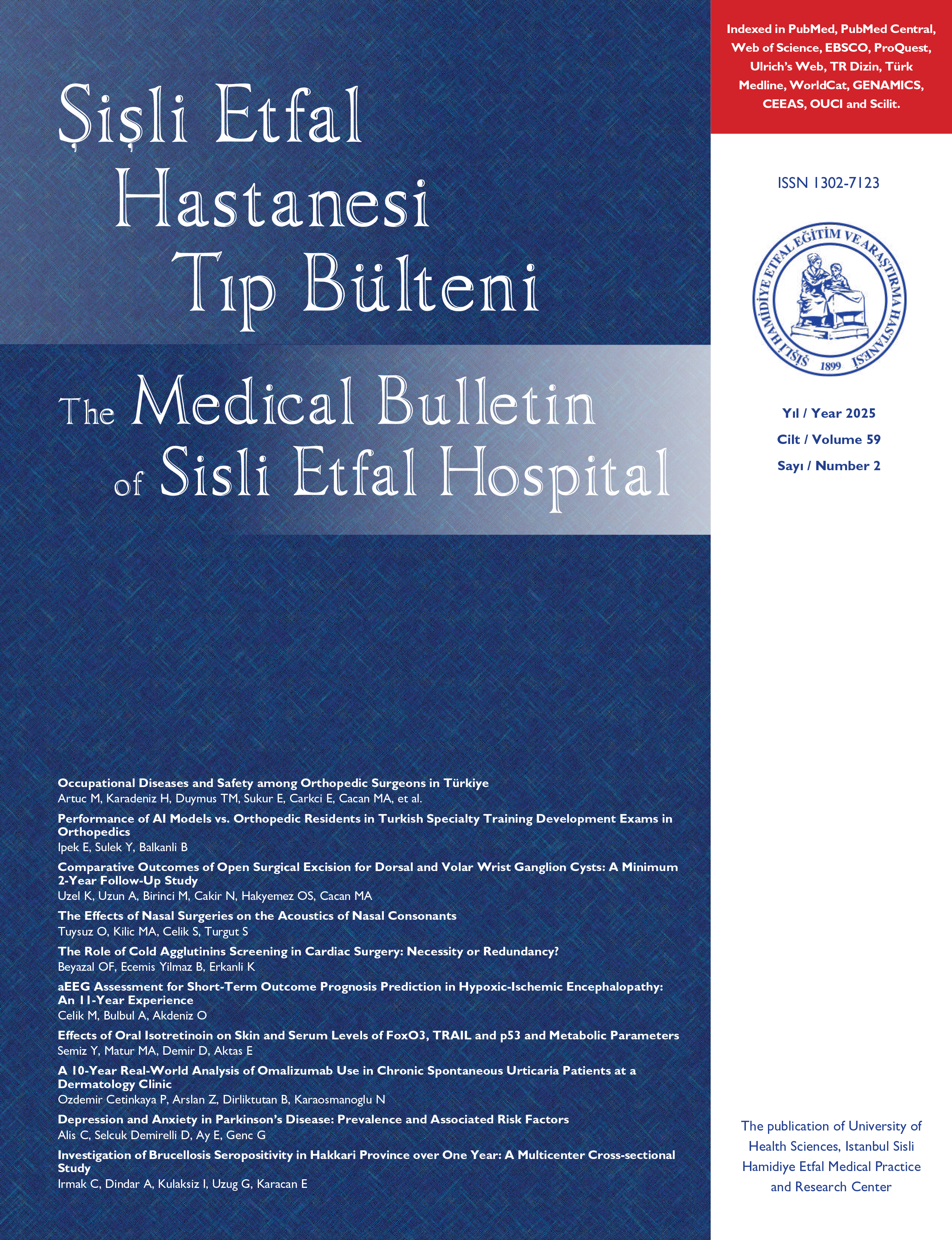
Hastane çalışanlarında işe bağlı kas iskelet sistemi hastalıkları: Üst ekstremite problemleri
Hülya Şirzai1, Beril Doğu2, Pınar Erdem3, Figen Yılmaz2, Banu Kuran41Ankara Fizik Tedavi ve Rehabilitasyon Eğitim ve Araştırma Hastanesi, Ankara-Türkiye2Şişli Hamidiye Etfal Eğitim ve Araştırma Hastanesi, FTR Kliniği, İstanbul-Türkiye
3Beykoz Devlet Hastanesi, İstanbul-Türkiye
4İstanbul Yeni Yüzyıl Üniversitesi, Sağlık Bilimleri Fakültesi, Fizyoterapi ve Rehabilitasyon Bölümü Öğretim Görevlisi, İstanbul-Türkiye
Amaç: İşe bağlı kas iskelet sistemi hastalıkları toplumda sık görülen sağlık problemlerinden biridir. Hastanemizde çalışan yardımcı personelin sağlığını korumak, iş memnuniyetini artırmak ve iş kaybına neden olabilecek durumları önleyebilmek için işe bağlı üst ekstremite problemlerinin sıklığı ve bu problemleri oluşturabilecek etmenleri belirlemeyi amaçladık.
Gereç ve Yöntem: Çalışmamıza, hastanemizde çeşitli bölümlerinde çalışan toplam 125 sağlık personeli dahil edildi. Çalışmanın verileri kişisel özellikleri, iş ve çalışma ortamı ile ilgili bilgiler literatürlerden derlenerek oluşturulan bir anket formuyla sorgulandı. İskandinav Kas-İskelet Sistemi Anketi (The Nordic Musculoskeletal Questionnaire) ile ağrı bölgeleri belirlendi.
Bulgular: Çalışmaya katılan 125 olgunun, 74ü (%59.2) kadın ve 51i (%40.8) erkek idi. Olguların yaş ortalamaları 31.56±7.09 yıldı. Katılımcıların 53 (%50.3)ü hastanede temizlik personeli olarak, 25 (%23.8)i sekreter, 16 (%15.2)sı teknisyen ve 11 (%10.6)i hemşire olarak çalışmaktaydı. Çalışanların 61 (%58.1)i iş sırasında üst ekstremitesi ile ilgili ağrısı olduğu saptandı. Yapılan logistik analizde erkek
olmak sadece el bileği ağrıları için risk faktörü, VKİnin büyük olması sırt, dirsek ve el bileği için; evde geçen sürenin az olması sırt ve elbileği ağrısı için risk faktörü olarak saptandı.
Sonuç: Hastane çalışanlarında işe bağlı oluşabilecek üst ekstremite problemleri ve risklerinin önceden belirlemek iş verimi ve çalışanları sağlığını korumak için önemlidir.
Anahtar Kelimeler: İşe bağlı ağrı, ergonomi, üst ekstremite, Nordic sorgulama anketi.
Work-related musculoskeletal diseases in hospital workers: Upper extremity problems
Hülya Şirzai1, Beril Doğu2, Pınar Erdem3, Figen Yılmaz2, Banu Kuran41Ankara Fizik Tedavi ve Rehabilitasyon Eğitim ve Araştırma Hastanesi, Ankara-Türkiye2Şişli Hamidiye Etfal Eğitim ve Araştırma Hastanesi, FTR Kliniği, İstanbul-Türkiye
3Beykoz Devlet Hastanesi, İstanbul-Türkiye
4İstanbul Yeni Yüzyıl Üniversitesi, Sağlık Bilimleri Fakültesi, Fizyoterapi ve Rehabilitasyon Bölümü Öğretim Görevlisi, İstanbul-Türkiye
Objective: The work-related musculoskeletal disorders are one of the most common health problems in the community. The aim of the our study was to determine the incidence of work-related upper extremity problems and to asses the risk factors in order to protect the health of our hospital employees, to improve job satisfaction and to avoid situations that could lead to job.
Material and Method: A total of 125 hospital employees were included in our study. The personal characteristics of the participants, information about the work and the working environment were questioned by a questionnaire that was collected from the literature. The Nordic Musculoskeletal Questionnaire was used to identify areas of pain.
Results: 125 cases participated in the study, 74 (59.2%) were female and 51 (40.8%) were male. The mean age of patients was 31.56±7: 09 years. 53 participants (50.5%) were cleaning staff, 25 participants (23.8%) were secretary, 16 participants (15.2%) were technician and 11 participants (10.6%) were nurse. 61 employees (58.1%) had upper limb pain during business. When logistic analysis was performed we found that male gender is a risk factor for wrist pain; high BMI is a risk factor for back, elbow and wrist; less time spent at home is a risk factor for back and wrist pain.
Conclusion: To determine the work-related upper extremity problems and risk factors in hospital employees is important to improve work efficiency and protect the health of employees.
Keywords: The work-related pain, ergonomic, upper limb, Nordic Musculoskeletal Questionnaire.
Makale Dili: Türkçe



















